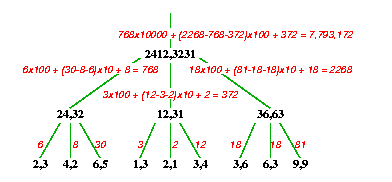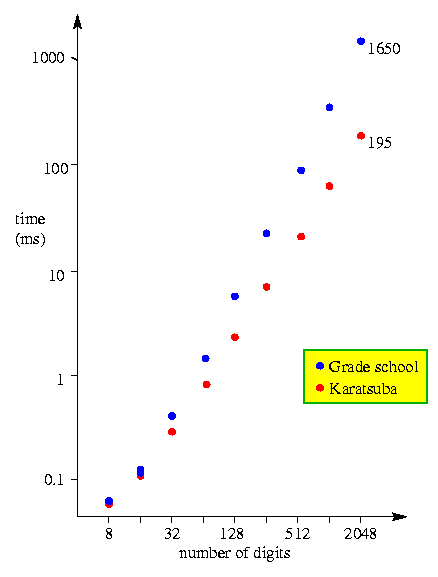
Grade-school multiplying
Divide-and-conquer multiplication
Algorithm
Theoretical analysis
Implementation tricks
Experimental comparison
We saw, through Mergesort, how recursion can lead to good algorithms for sorting, using a technique called divide and conquer. Today I want to look at a completely different problem, in which the same technique applies: Multiplying numbers. Today, we're going to learn a new, faster way to multiply numbers.
In particular, we're interested in algorithms for multiplying together very large numbers - like numbers with hundreds of digits. We're interested in the case with both numbers have n digits, when n is very large.
You probably learned to multiply multi-digit numbers in grade school. This technique didn't involve any recursion.
2412
x 3231
---------
2412
7236
4824
+ 7236
---------
7793172
Analyzing this algorithm using big-O analysis proceeds in two steps, just like the algorithm. First, we look at the amount of time it takes to write the n numbers below the line. Each number takes O(n) time to compute, and there are n numbers, for a total of O(n2) time for this first phase.
The second phase is the addition phase. For this phase, we go through each of the 2n columns, totalling the up to n digits within the column (plus an additional number obtained from the carry of the previous column). Each column takes O(n) time, and so the overall time for this phase is O(n2).
The total time for both phases of the grade-school algorithm, therefore, is O(n2) + O(n2) = O(n2).
There is a faster way to multiply, though, caled the divide-and-conquer approach. The introduction of the technique is attributed to a 1962 paper by Karatsuba, and indeed it is sometimes called Karatusba multiplication.
With divide-and-conquer multiplication, we split each of the numbers into two halves, each with n/2 digits. I'll call the two numbers we're trying to multiply a and b, with the two halves of a being aL (the left or upper half) and aR (the right or lower half) and the two halves of b being bL and bR.
Basically, we can multiply these two numbers as follows.
aL aR
x bL bR
-----------------
aLbR aRbR
+ aLbL aRbL
--------------------------
aLbL (aLbR + aRbL) aRbR
Thus, in order to multiply a pair of n-digit numbers, we can recursively multiply four pairs of n/2-digit numbers. The rest of the operations involved are all O(n) operations. (Multiplying by 10n may look like a multiplication (and hence not O(n)), but really it's just a matter of appending n zeroes onto the number, which takes O(n) time.)ab = (aL 10n/2 + aR) (bL 10n/2 + bR) = aL bL 10n + aL bR 10n/2 + aR bL 10n/2 + aR bR = aL bL 10n + (aL bR + aR bL) 10n/2 + aR bR
That's fine as far as it goes, but it turns out that it's not far enough: If you write down the recurrence and solve it, it turns out to solve to O(n2), which is what we had from grade school. And this algorithm is much more complicated. Not a very encouraging result.
But there turns out to be a very clever approach, we permits us to reduce the number of n/2-digit multiplications from four to three! This clever idea yields a better result.
The idea works as follows: We're trying to compute
What we'll do is compute the following three products using recursive calls.aL bL 10n + (aL bR + aR bL) 10n/2 + aR bR
These have all the information that we want, since the following is true.x1 = aL bL x2 = aR bR x3 = (aL + aR) (bL + bR)
And we already reason that this last is equal to the product of a and b.x1 10n + (x3 - x1 - x2) 10n/2 + x2 = aL bL 10n + ((aL bL + aL bR + aR bL + aR bR) - aL bL - aR bR) 10n/2 + aR bR = aL bL 10n + (aL bR + aR bL) 10n/2 + aR bR
In pseudocode, I might write down the algorithm this way. (This is just pseudocode, even though it may look like Java. But the Java would be quite a bit more complex, without really giving you much of an idea.)
BigInteger multiply(BigInteger a, BigInteger b) {
int n = max(number of digits in a, number of digits in b)
if(n == 1) {
return a.intValue() * b.intValue();
} else {
BigInteger aR = bottom n/2 digits of a;
BigInteger aL = top remaining digits of a;
BigInteger bR = bottom n/2 digits of b;
BigInteger bL = top remaining digits of b;
BigInteger x1 = Multiply(aL, bL);
BigInteger x2 = Multiply(aR, bR);
BigInteger x3 = Multiply(aL + bL, aR + bR);
return x1 * pow(10, n) + (x3 - x1 - x2) * pow(10, n / 2) + x2;
}
}
Let's do an actual multiplication to illustrate how this works. I'm going to draw a recursion tree, labeling the edges with the final values computed by each node of the tree.

We're going to do the same form of analysis we did for Mergesort: We'll draw a recursion tree, labeling each node with the amount of time consumed outside the recursive calls, and then we'll find the sum of all the nodes of the recursion tree to get the total time.
All of the calculations of divide-and-conquer multiplication take O(n) time, except the three recursive multiplications. The three multiplications are to n/2-digit numbers. (Actually, the last multiplicaiton could be to (n/2+1)-digit number, but this extra digit turns out not to affect the analysis. It complicates the analysis considerably, and so we'll ignore it.)
So here's the recursion tree. I'll label each node with the number of digits in each number of the pair being multiplied.
n
n/2 n/2 n/2
n/4 n/4 n/4 n/4 n/4 n/4 n/4 n/4 n/4
n/8 n/8 n/8 n/8 n/8 n/8 n/8 n/8 n/8 n/8 n/8 n/8 n/8 n/8 n/8 n/8 n/8 n/8 n/8 n/8 n/8 n/8 n/8 n/8 n/8 n/8 n/8
: : : : : : : : : : : : : : : : : : : : : : : : : : :
1 1 1 1 1 1 1 1 1 1 1 1 1 1 1 1 1 1 1 1 1 1 1 1 1 1 1
The times for the first level sum to n; the times for the second sum to (3/2)n; for the third, (9/4)n; for the fourth, (27/8)n; and so on, each time going up by a factor of 3/2. The last level will sum to (3/2)log2 n n.
We're going to simplify the total over all levels.
3 3 2 3 3 3 log2 n
n + --- n + (---) n + (---) n + ... + (---) n
2 2 2 2
3 3 2 3 3 3 log2 n
= n ( 1 + --- + (---) + (---) + ... + (---) )
2 2 2 2
k+1
2 3 k r - 1
1 + r + r + r + ... + r = --------
r - 1
1+log2 n
(3/2) - 1 ( 3 3 log2 n )
n ------------------- = 2 n ( --- (---) - 1 )
3/2 - 1 ( 2 2 )
log2 n
3 log2 n 3 log2 n
= 3 n (---) - 2 n = 3 n --------- - 2n = 3 3 - 2n
2 log2 n
2
log2 3 1.585
= 3 n - 2n = O(n )
(The last step, where we replaced 3log2 n with nlog2 3, comes from an identity I know that xlogb y = ylogb x. It can be proven with the following reasoning.
(logb x) (logb y) = (logb y) (logb x)
logb x logb y
logb y = logb x
logb x logb y
y = x
(Incidentally, divide-and-conquer multiplication isn't the fastest known multiplication algorithm. The best known result is an O(n log n) algorithm. It's quite a bit more complicated, and I'm not sure if it's practical for reasonably sized numbers.)
It happens that I've written one of the faster divide-and-conquer multipliers out there. Implementing algorithms quickly is a bit of a trick. There are three tricks that my implemantion uses.
This saves in two respects: First, it means that we avoid extra, unnecessary computation while the recursion is going on, saving all the carrying to one quick pass at the end. (It would amount to several passes if we did the carry as we go along.) And second, it means we don't have to worry about the annoying extra digit that can pop up in computing x3.

In January 1999, I implemented the program in C++ and timed it on a Sun SPARCstation 4. (It was an antiquated computer even at that time. A later test on a 700MHz Pentium II did about 50 times better.) The below results are the results for pairs of random n-digit numbers. (Yes, digits. I implemented it in decimal.) All times are in milliseconds.
| # digits | divide-and-conquer | grade school |
|---|---|---|
| 8 | 0.059923 | 0.063902 |
| 16 | 0.106360 | 0.121773 |
| 32 | 0.278862 | 0.414594 |
| 64 | 0.798085 | 1.481481 |
| 128 | 2.325581 | 5.780347 |
| 256 | 6.944444 | 22.727273 |
| 512 | 21.276596 | 88.333333 |
| 1024 | 63.750000 | 370.000000 |
| 2048 | 195.000000 | 1650.000000 |
Of course, this begs the question: Why would one want to multiply 100-digit numbers with exact precision? One response is cryptographic applications: Some protocols (including RSA) involve many multiplications of keys with hundreds of digits. (Another application is to breaking mathematical records (largest prime, whatever), but it's not clear how practical this is.)